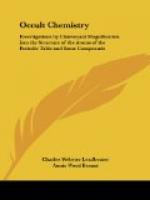When we go on to chromium and molybdenum, we return to our familiar funnels and central globes, and the secondary spheres within the funnels—quickly set free, as before, on the proto level—give us no new combinations in their contained spheres and ovoids. The a of beryllium, the b of calcium and strontium, and d of calcium, the e and f of strontium, are all there; j in chromium is the same as the central sphere in the b ovoid. In the central globe, k, is a pair of triangles as in hydrogen, consisting of only six atoms, which on the meta level revolve round each other, and break up into two duads and two units on the hyper.
MOLYBDENUM (PLATE VIII, 6).
Molybdenum presents us with only two new forms, and these are merely four-atomed tetrahedra, occurring in pairs as object and image. All the other bodies have already been analysed.
II a.—We come now to the second great tetrahedral group, which though very much complicated, is yet, for the most part, a repetition of familiar forms.
MAGNESIUM (PLATE IX, 1).
[Illustration]
We are still among tetrahedra, so have to do with four funnels, but each funnel contains three rings, and each ring three ovoids; on the proto level a triple dissociation takes place, for the funnels let free the rings as large spheres, in each of which rotate three twelve-atomed ovoids, and then the ovoids break loose from the spheres, and themselves become spherical, so that we have finally thirty-six proto compounds from the tetrahedron. On the meta level the contained bodies, a triplet, Mg a, a septet, Mg b, and a duad, Mg c, are set free from each globe, thus yielding one hundred and eight meta compounds. On the hyper level the triplet becomes a duad and a unit; the duad becomes two units; and the septet a triplet and a quartet.
ZINC (PLATE IX, 2).
We can leave aside the funnel, for the only difference between it and the magnesium funnel is the substitution of a second septet for the triplet, and the septet is already shown in the magnesium diagram. We have, therefore, only to consider the spikes, pointing to the angles of the enclosing tetrahedron, and the central globe. These are set free on the proto level and the spikes immediately release their contents, yielding thus thirty-two separate bodies.
The triangular arrangement at the top of the spike is the same as occurs in copper (b on p. 48), and can be there followed. One of the three similar pillars is shown in the accompanying diagram under Zn a. The compressed long oval becomes a globe, with six bodies revolving within it in a rather peculiar way: the quartets turn round each other in the middle; the triplets revolve round them in a slanting ellipse; the duads do the same on an ellipse slanting at an angle with the first, somewhat as in gold (a and b, p. 40). The spheres within the globes at the base of the spikes, Zn b, behave as a cross—the cross is a favourite device in the II a groups. Finally, the central globe, Zn c, follows the same cruciform line of disintegration.




